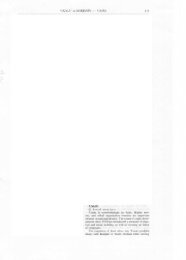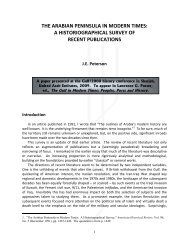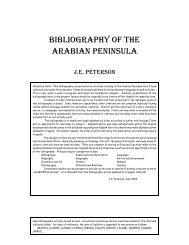Chatty, Dawn, and J.E. Peterson. “Oman” Carol R ... - JEPeterson.net
Chatty, Dawn, and J.E. Peterson. “Oman” Carol R ... - JEPeterson.net
Chatty, Dawn, and J.E. Peterson. “Oman” Carol R ... - JEPeterson.net
Create successful ePaper yourself
Turn your PDF publications into a flip-book with our unique Google optimized e-Paper software.
Persian Gulf<br />
Abu Dhabi<br />
Sabkhat Matti ¸¸<br />
(salt flat)<br />
AR RUB' AL KHALI ¯ ¯<br />
¸<br />
Arabian<br />
Sea<br />
Umm as<br />
Samim<br />
(salt flat)<br />
¯<br />
ZUFAR<br />
of Hormuz<br />
S trait<br />
Al Khasab ¸<br />
Al'Ayn<br />
UNITED ARAB EMIRATES<br />
SAUDI<br />
ARABIA<br />
Habarut ¯<br />
YEMEN<br />
Oman<br />
0<br />
OMAN<br />
100<br />
0 100 200 Kilometers<br />
Rakhyut ¯<br />
Dawkah<br />
200 Miles<br />
Hasik ¸ ¯<br />
Al Qabil ¯<br />
Dank ¸<br />
Sadh ¸ ¸<br />
Ra's Mirbat ¯¸<br />
Bay'ah<br />
Adam<br />
Jiddat<br />
al Harasis<br />
¸ ¯<br />
Sharbatat ¯<br />
Shinas ¯¸<br />
Suhar ¸ ¯<br />
Jabal ash<br />
Sham<br />
9,777 ft.<br />
2980 m.<br />
Gulf of<br />
Oman<br />
Matrah ¸ ¸<br />
AL JABAL<br />
Duqm<br />
W<br />
Ghubbat<br />
Sawqirah ¸<br />
Sawqirah ¸<br />
Ra's alsh Sharbatat ¯<br />
Jaza'ir ¯ Hallaniyat<br />
¸ ¯ ¯<br />
(Kuria Muria Is.)<br />
¸<br />
Khaluf ¯<br />
HISTORY AND ETHNIC RELATIONS<br />
N<br />
S<br />
IRAN<br />
Muscat<br />
Sur ¸ ¯<br />
As Suwyh¸<br />
Al Ashkharah<br />
Jazirat Masi ¸ rah<br />
Khalij<br />
Masirah<br />
¸<br />
Dawwah<br />
Ra's al Madrakah<br />
Oman<br />
Emergence of the Nation. Oman has a very long<br />
history <strong>and</strong> was known as Magan to ancient Persian<br />
<strong>and</strong> Mesopotamian civilizations <strong>and</strong> was an<br />
important producer of copper <strong>and</strong> ornamental<br />
stone. The Arab tribes in Oman adopted Islam during<br />
the lifetime of the prophet Muhammad (c.570–<br />
632) <strong>and</strong> forced the Persian colonizers to leave. Since<br />
then, Oman has generally remained an independent<br />
Arab <strong>and</strong> Ibadi/Sunni Muslim entity.<br />
E<br />
OMAN<br />
1682<br />
National Identity. The Omani national identity<br />
has evolved from its predominant Arab language<br />
<strong>and</strong> culture, its tribal organization, <strong>and</strong> Islam.<br />
Oman withstood attempts by classical Islamic<br />
empires to subdue the country, <strong>and</strong> the Portuguese<br />
invasion of the sixteenth century was confined to<br />
coastal ports <strong>and</strong> was terminated by national Omani<br />
resistance in the mid-seventeenth century.<br />
Ethnic Relations. Although the dominant cultural<br />
group in Oman is Arab <strong>and</strong> Ibadi/Sunni Muslim,<br />
the culture has been very tolerant of other groups.<br />
Ethnic, sectarian, or linguistic conflict rarely occurs<br />
in Oman although tribal disputes are not unknown.<br />
URBANISM, ARCHITECTURE, AND THE USE<br />
OF SPACE<br />
The contemporary urban character of Omani culture<br />
has strong ties to Indian Mogul architectural<br />
style. This is manifested in the seafront whitewashed<br />
two- <strong>and</strong> occasionally three-story residential<br />
buildings that line the road along the harbor of<br />
Matrah (Muscat’s sister city). It is also seen in the<br />
style of some mosques <strong>and</strong> minarets with their slim<br />
<strong>and</strong> ornate shapes, as well as in public buildings<br />
such as the Ministry of Foreign Affairs building in<br />
Qurm. Other contemporary constructions are more<br />
eclectic in style.<br />
Earlier architectural styles found in the towns<br />
<strong>and</strong> interior cities of Oman, such as Nizwa, Ibri,<br />
Ibra, <strong>and</strong> Bahla, reflected a pared down <strong>and</strong> simpler<br />
cultural expression <strong>and</strong> use of space that was consistent<br />
with Ibadism, a relatively austere form of<br />
Islam.<br />
Private residences reflect the culture’s concern<br />
for gendered space. Most Omani homes have formal<br />
rooms for men <strong>and</strong> their visitors, while women<br />
generally socialize in each other’s private quarters.<br />
When people meet to mark various rites of passage,<br />
such as births, marriages, <strong>and</strong> deaths, the celebrations<br />
are marked by clear gendered space. It is<br />
women who visit other women on the occasion of a<br />
birth in a family. Marriage rituals entail elaborate<br />
celebrations for women only, for men only, <strong>and</strong>,<br />
when space is open, with segregated sitting areas.<br />
Deaths are similarly marked by gendered use of<br />
space, with only men attending the actual burial of<br />
a body.<br />
FOOD AND ECONOMY<br />
Food in Daily Life. Omani cuisine revolves around<br />
rice. The morning meal is not significant, often<br />
consisting of bread or leftovers from the day before,







